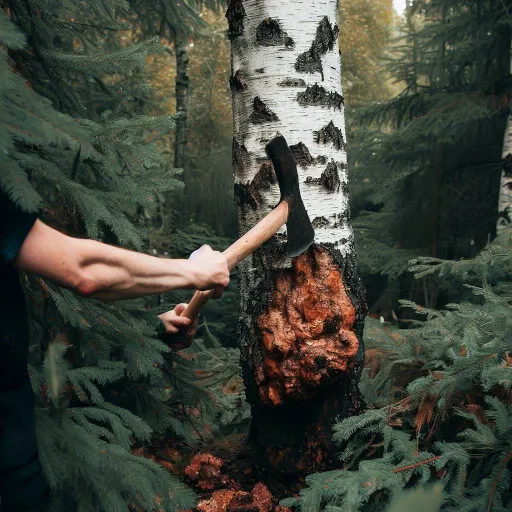Iowa City (319) 321-6401 |

Brunei Kratom: A Comprehensive Guide to Effects and Dosage
Imagine navigating the dense rainforests of Brunei, uncovering the hidden

Harvesting Chaga can be a rewarding experience. It’s a great way to connect with nature and reap the health benefits of this amazing fungus. Take my friend, Susan, for example; she recently harvested her first batch of Chaga with great success.
She was able to identify the right spot, gather the right tools, and store it properly for future use. In this article, I will give you an in-depth guide on how to do the same! From identifying Chaga to gathering the materials needed for harvesting, I’ll provide all the information you need so that you can start your own Chaga harvesting adventure. Let’s learn how to harvest Chaga!
Related: If you’re interested in natural remedies, you’ll love our in-depth article on the incredible benefits of Chaga Mushroom! Click here to discover its healing properties.
Table of Contents:
Identifying Chaga correctly is essential so you know what you’re looking for! Chaga is a mushroom that grows on birch trees and can look like a hard, blackened lump or even resemble burnt charcoal. The easiest way to spot Chaga is by its cracked surface with orange or brown patches underneath.
Once you’ve found Chaga, use preserving methods such as freezing or drying it immediately so the fungus remains viable and ready for harvest when needed. Even though it has an unusual appearance, identifying signs of Chaga is relatively easy if you take the time to look closely at the tree’s bark. The cracks in the bark are a good indicator of where this edible mushroom might be hiding!
Choosing the right tools for gathering mushrooms is an essential part of successful foraging; up to 80% of a mushroom hunter’s success can depend on having the correct gear. When harvesting Chaga, it’s important to select tools that are sustainable and designed with aging Chaga in mind.
A knife or small ax is necessary to remove the Chaga from the tree. When removing it, it’s best to pick one that won’t damage the tree. Additionally, gloves should be worn when handling Chaga as some individuals may experience skin irritation from contact with its spores.
A basket or bag handy is also helpful for carrying your bounty back home! Though there are no hard and fast rules when it comes to choosing harvesting tools, being mindful of sustainability and not damaging trees while extracting chunks of Chaga will go a long way towards becoming a successful Chaga harvester!
Once you’ve got the right tools, it’s time to prep your harvesting site! Before harvesting Chaga, it is essential to consider the environment in which you are doing so. If possible, identify a large tree infected with Chaga and avoid disturbing surrounding vegetation.
It’s also essential to ensure that the area around the tree is not too densely vegetated so that you have enough space for collecting your harvest. Planting trees near your harvesting site can also help preserve habitat while providing potential future sources of Chaga.
Planning and ensuring you are adequately prepared before beginning any harvesting activities is always a good idea.
When collecting Chaga, there’s no time to waste – it’s an absolute must! The collection of Chaga requires precision and attention to detail to ensure that the highest quality mushrooms are obtained.
Here are some guidelines for collecting Chaga responsibly:
Properly storing your Chaga mushrooms is essential for getting the most out of them and ensuring their quality over time, so you’ll want to know the best way to do it. To start, it’s essential to find a dry place with good air circulation to hang or spread your collected Chaga.
This allows the mushrooms time to properly dry out before they are ready for use. However, if you’d rather not wait for natural drying techniques, there are other ways to speed up the process, like using a food dehydrator or an oven set at its lowest temperature setting. Once dried thoroughly, your Chaga can be stored in an airtight container away from direct sunlight.
When you’re ready to use it, plenty of brewing methods will bring out its full flavor and health benefits! Whether you choose boiling water or a cold infusion method like steeping overnight in room-temperature water – remember that proper storage is key for keeping your Chaga fresh and flavorful.
Harvesting Chaga is a rewarding experience that requires knowledge and skill. You can easily collect this beneficial mushroom (improved immune system function, reduce cholesterol levels, reduced inflammation, cancer fighting, liver protection) with the right tools, like an axe or saw, and the proper knowledge of how to identify and prepare a harvesting site.
By storing it in dry conditions, such as a sealed bag in your refrigerator or freezer, you can keep it fresh until you’re ready to use it. As the old adage goes: “Gather ye Chaga while ye may,” so don’t miss out on this delicious fungus – harvest Chaga now!
Related: Chaga Mushroom Tea
Related: How to Use Chaga Mushroom

Imagine navigating the dense rainforests of Brunei, uncovering the hidden

Have you ever wondered why Trainwreck Kratom has sparked such

To effectively combat headaches, specific Kratom strains stand out for
Subscribe for exclusive deals and updates!
